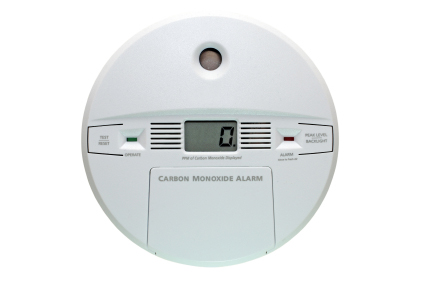With the heating season underway, the threat of carbon monoxide poisoning increases. This is because furnaces, space heaters, kerosene heaters, gas water heaters, wood stoves and fireplaces all produce this colorless, odorless gas. When a fuel-burning appliance is not operating correctly or has improper ventilation, carbon monoxide (CO) can find its way into your business or home.
How is carbon monoxide produced?
When fuel such as gas, oil, kerosene, wood or charcoal is burned, CO is produced. The amount produced varies depending on the quality of efficiency of combustion. While a properly functioning burner produces little CO, an out-of-adjustment burner could produce life-threatening amounts – without any warning signs.
What can be done to prevent harmful CO amounts?
Fuel-burning appliance need to be maintained and used properly to limit the amount of CO produced. In addition, they need proper ventilation, especially during warm-up and self-cleaning operation. Check for rust on fuel-burning appliances – a sign that ventilation is an issue.
What is important in selecting a carbon monoxide alarm?
When choosing a carbon monoxide detector, make sure it meets the requirements of Underwriters Laboratories (UL) or International Approval Service (IAS). Some alarms will provide warnings for lethal and nonlethal levels of CO. To properly maintain them, keep them free of dust and debris and check the batteries every month.
What are the signs and symptoms of Carbon Monoxide poisoning?
The symptoms of carbon monoxide poisoning are incredibly similar to those of the flu, including headache, sore throat, rapid heartbeats, memory loss, and sensitivity to lights and smells. In fact, of the 12,000 patients in the United States each year complaining of flu-like symptoms, it is estimated that 2,000 of these individuals are suffering from carbon monoxide poisoning.
If you experience any of the above symptoms of carbon monoxide poisoning, get fresh air immediately and seek medical attention. According to the Centers for Disease Control and Prevention (CDC), 20,000 people visit the emergency room every year because of carbon monoxide poisoning. 500 of these individuals never leave.
For more information about Carbon Monoxide Detectors and how to ensure the mechanical equipment in your commercial building runs efficiently, properly and reliably, contact Crockett Facilities Services – a commercial mechanical contractor and HVAC service provider for Maryland, D.C. and Virginia. Call 301.262.2771 or email us at sales@crockett-facilities.com. We’re In This Building Together!
Like us on Facebook; follow us on LinkedIn, Twitter, and Google+

